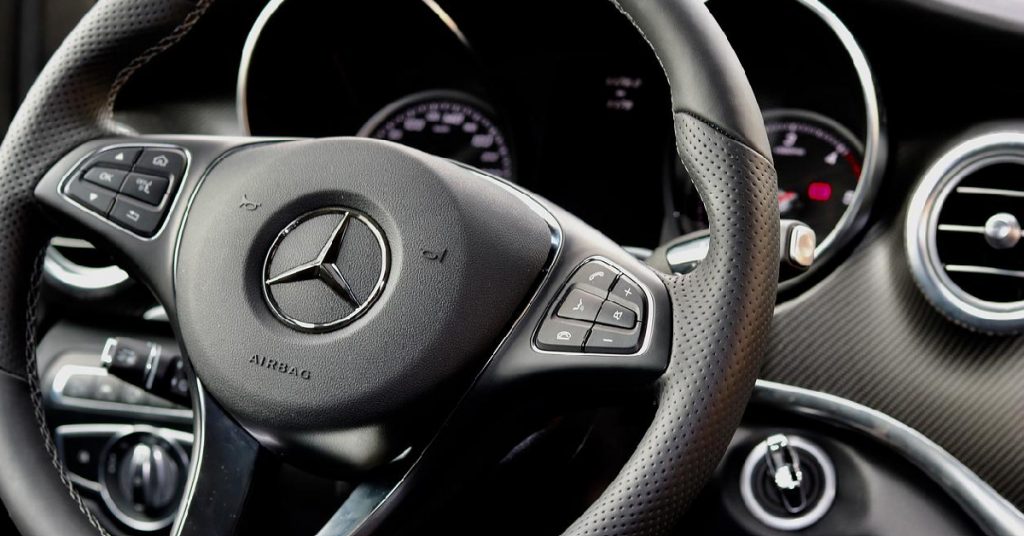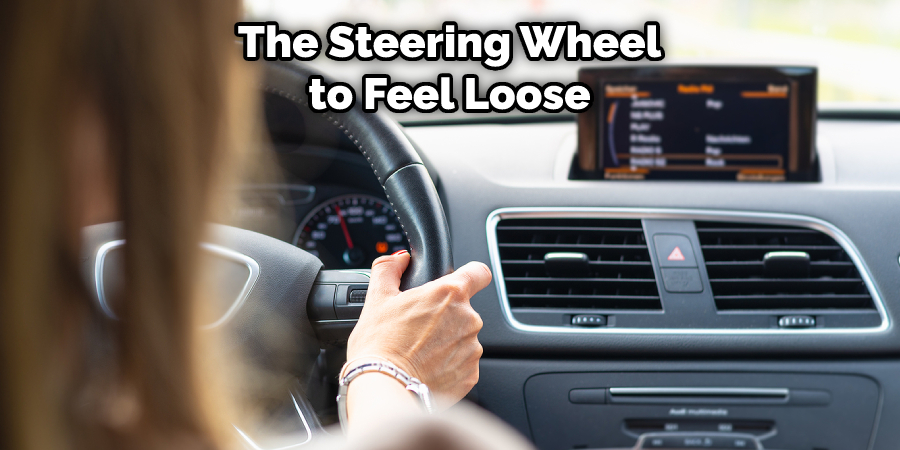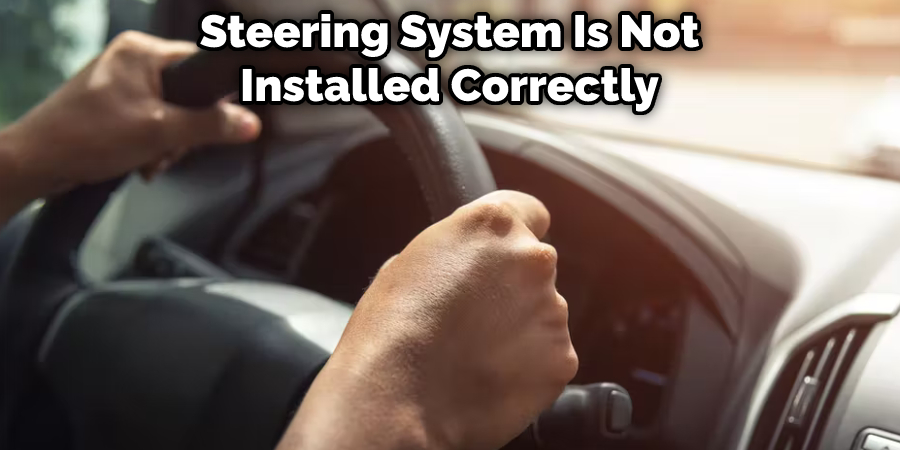If you’re like most drivers, the last thing you want is a loose steering wheel. It can make it difficult to control your car and even lead to accidents. In this article, we’ll show you how to fix a loose steering wheel using a few simple tools. So if your car is feeling a bit wobbly, keep reading to learn more!
The steering wheel is an essential part of a car, so it is necessary to have a grip on it. If it becomes loose, then it can create problems while driving. Unfortunately, many people don’t know how to fix their loose steering wheel and take their car to the mechanic. This can be expensive, so it’s best to learn how to do it yourself!

Summary: If you find that your steering wheel is loose, there are a few things you can do to fix the issue. First, check to see if the screws that hold the wheel to the column are missing or if they’re loose. If the screws are missing, you’ll need to replace them. Once the screws are tightened, you can try tightening the wheel’s alignment bolt. If that doesn’t work, you may need to replace the entire steering column.
What Causes a Steering Wheel to Be Loose?
Worn and Tear:
Worn and tear is the most common reason a steering wheel becomes loose. Over time, the parts of your steering system will begin to wear down, causing them to loosen and become less effective. If you notice that your steering wheel is becoming loose, have your vehicle inspected by a qualified technician as soon as possible.
Misalignment:
Another common cause of a loose steering wheel is misalignment. When your wheels are out of alignment, it puts extra strain on your steering system, causing the parts to loosen and eventually fail. If you notice that your steering wheel is loose, take your car to a mechanic to have it checked. They can perform an alignment and check for any other issues that might be causing the problem.
Damaged Parts:
Damaged or broken parts can also cause a steering wheel to become loose. If any of the components in your steering system are damaged, they will no longer be able to function correctly, causing your steering wheel to become loose.
Substandard Tire Pressure:
Most of the time, a loose steering wheel results from incorrect tire pressure. Check and adjust your tires’ pressure to the levels specified in your car’s owner’s manual. You can find this information on a sticker inside the driver’s door or the glove box lid.
If you have an electronic stability control (ESC) system, make sure it is turned off before you start driving. ESC will not work correctly if any of the tires are underinflated.
Worn Out Suspension Component:
The most likely cause of a loose steering wheel is a worn-out suspension component called the lower control arm bushing. These bushings connect the lower control arm to the car’s frame and allow it to pivot. Over time, these bushings can wear out, causing the lower control arm to move around more than it should. This movement will cause the steering wheel to feel loose.

Brake Problem:
If you have a loose steering wheel, your brake system likely is to blame. There are several potential causes of this problem, but a worn or damaged brake caliper is the most common. In some cases, the problem may be with the brake lines themselves. Whatever the cause, it’s essential to get the problem fixed as soon as possible.
What are the Signs of a Loose Steering Wheel?
Before fixing a loose steering wheel, it is essential to know the signs. Here are some things to look for:
- The Steering Wheel Feels Loose When Turning: If you feel like the steering wheel is loose or floppy when you turn it, this is a sign that it is not tight enough.
- There is Play in the Steering Wheel: Another way to tell if your steering wheel is too loose is by checking for play. Grab the steering wheel at 3 and 9 o’clock and see if you can move it back and forth. If there is any movement, then the steering wheel is too loose.
- The Steering Wheel Shakes When Driving: If the steering wheel shakes when you are driving, this could signify several different problems. For example, it could be that the wheels are out of balance or that the steering wheel itself is loose.
- The Steering Wheel Returns to Center Slowly After Turning: If the steering wheel takes a long time to return to center after you turn it, this could be another sign that it is too loose.
If you notice any of these signs, your steering wheel is most likely loose and needs to be fixed.
You Can Check It Out to Repair a Rim Blow Steering Wheel
A Step by Step Guide on How to Fix a Loose Steering Wheel
Step 1. Determine the Cause of the Loose Steering Wheel
The first step is to identify the cause of the problem. There are three main reasons why steering wheels become loose:
- Worn Out Parts: Over time, certain parts of the steering system will wear out and need to be replaced. This is most common in older vehicles.
- Damaged Parts: If any part of the steering system is damaged, it can cause the steering wheel to become loose. This could be due to an accident or hitting a pothole.
- Improper Installation: If the steering system is not installed correctly, it can cause the steering wheel to become loose. This is most common in aftermarket products.

Step 2. Adjust Steering Wheel Alignment
Over time, your steering wheel may become misaligned. This can cause the wheel to feel loose when you turn it. To fix this, you’ll need to adjust the alignment of your steering wheel.
First, loosen the adjustment screws on the side of the steering wheel column. Then, turn the wheel until it is aligned with the front wheels. Finally, tighten the screws to secure the new position.
If your steering wheel is still not aligned correctly, you may need to have it professionally realigned.
Step 3: Replace Damaged Parts
If the cause of your loose steering wheel is damaged parts, you’ll need to replace them. The most common problem is a worn out or damaged steering rack. To replace the rack, you’ll need to remove the old one and install the new one in its place.
Another common problem is a damaged steering shaft. This can be caused by accident or hitting a pothole. If the shaft is damaged, it will need to be replaced.
Step 4: Tighten All Bolts and Screws
Once you’ve replaced any damaged parts, it’s important to tighten all of the bolts and screws. This will ensure that everything is secure and won’t come loose again.
Start by tightening the bolts that connect the steering rack to the vehicle’s frame. Then, tighten the bolts that connect the steering column to the rack. Finally, tighten the adjustment screws on the side of the steering wheel column.
If you’re still having trouble, it’s best to consult a professional mechanic. They will be able to help you find and fix the problem.

Step 5: Check Tire Pressure and Alignment
If your steering wheel is still loose after following these steps, the problem may be with your tires. First, check the pressure of all four tires. If they are low, inflate them to the proper level.
Next, check the alignment of your tires. If they are out of alignment, they can cause the steering wheel to feel loose. To fix this, you’ll need to have your tires professionally aligned.
Step 6: Repair Brake Issues
If your brake pedal feels spongy or soft, this is a sign that you have air in your brake lines. To bleed the brakes, you’ll need to:
- Locate the bleeder valve on each wheel. The valves are usually located on the caliper near the top.
- Put a catch pan under the bleeder valve and open it up with a wrench.
- Pump the brake pedal a few times until you see fluid coming out of the valve. Ensure to keep an eye on the fluid level in your catch pan so it doesn’t run dry.
- Close up the bleeder valve when finished and move on to the next wheel.
Brake bleeding can be a messy job, so be prepared with plenty of rags and clean up any spills immediately. Once you’re finished, your brake pedal should feel firm when you press it.
You Can Check It Out Can You Repair Forged Wheels
Frequently Asked Questions
What Causes Steering Wheel to Be Loose?
There are several possible explanations for a loose steering wheel, but the most likely one is that the ball joint has failed. This is a mechanical link between the hubcap and the car’s axle, and when it fails, it can cause excessive play in the steering column. The other main cause of steer wheel looseness is worn or maladjusted tie-rod ends. When these get stretched out from too much turning or heavy braking, they can lose their grip on the chassis tube and start to drag. Finally, improper installation of suspension components such as shocks or struts can also lead to excessive movement in your steering wheel.
If you’re experiencing excess play in your steered wheels, it may be time to have them replaced altogether. In any case, always consult with an expert mechanic before making any decisions about repairs or replacements!
Will Wheel Alignment Fix Loose Steering?
If your car is having trouble turning in a tight space or making sharp turns, it might be because the steering alignment is off. A mechanic will need to do some tests to figure out what the problem is and how to fix it.
What Causes Excessive Play in Steering?
One of the most common causes of excessive play in the steering is loose bushing. A loose bushing can cause your wheels to turn excessively, which can lead to dangerous and unnecessary turns. In order for this issue to be resolved, you will need to take it to your mechanic’s shop for repair or replacement.
While there are many other potential causes of excessive play in the steering, these are some of the more common ones that should be examined by a professional.
Can Tires Affect Steering?
There are many myths surrounding tires and steering, but the reality is that there is limited evidence to support any of these claims. In most cases, tires do not affect your ability to steer – if they did, then cars with bigger wheels would be more challenging to drive. Instead, uneven wear on your tire’s surface may cause a wobble in your car’s suspension or affect how smoothly the wheel turns when you turn it. This can make driving difficult and potentially dangerous. If you notice an unusual amount of shake or vibration when turning your car, it might be best to have a look at your tires for damage or poor performance.
Conclusion
A loose steering wheel can be dangerous and should be fixed as soon as possible. However, if you are unsure how to fix a loose steering wheel, take your car to a mechanic. They will have the tools and knowledge necessary to get your car back on the road in no time.
